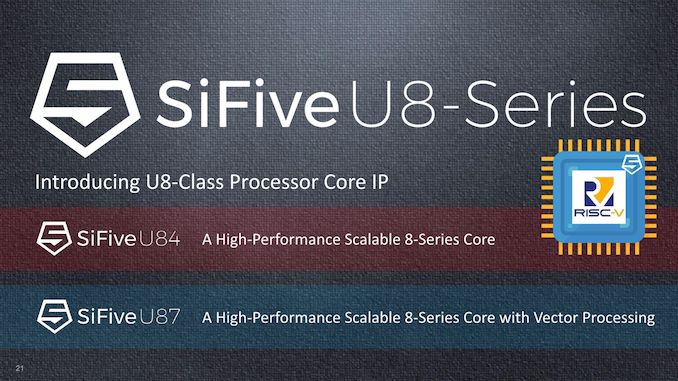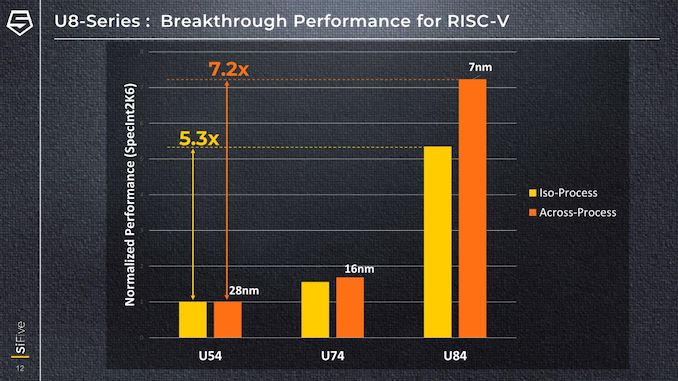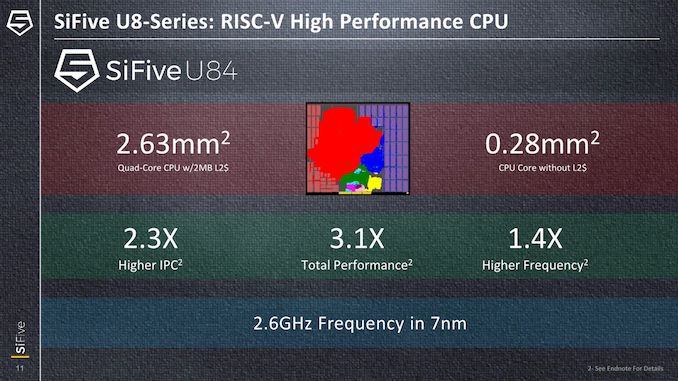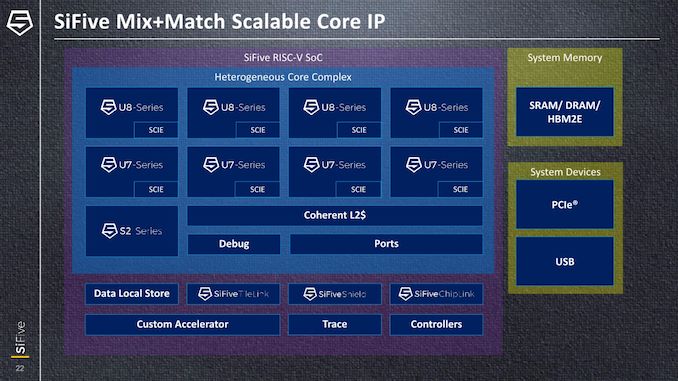SiFive Announces First RISC-V OoO CPU Core: The U8-Series Processor IP
by Andrei Frumusanu on October 30, 2019 10:00 AM ESTPerformance Targets, PPA and Conclusion
The U8-Series microarchitecture will initially be productized as two IP offerings: The U84 and the U87 CPU cores:
The U87 will only be available later next year, whilst the U84 is also being finalised right now. The company has the U84 IP running internally on FPGA platforms.
The performance increases compared to previous generation SiFive cores are extremely impressive: Against a U54 at ISO-process, the new U84 features a 5.3x performance increase in SPECint2006. When taking into account the process node improvements that allow the U84 to clock higher, the generational increases that we’d be seeing in products will be more akin to a factor of 7.2x.
In terms of PPA, compared to a U7-series CPU, IPC increases come in at 2.3x resulting in 3.1x higher performance (ISO-process). A lot of the performance increases of the U8-series come thanks to the increased frequencies capabilities which are 1.4x higher this generation, with the core scaling up to 2.6GHz on 7nm.
On the same 7nm process, the U84 lands in at 0.28mm² per core and a cluster comprising four cores and a 2MB L2 cache measure in at 2.63mm². For comparison, a Arm Cortex-A55 as measured on the Kirin 980, also on 7nm, a core with its 128KB private L2 cache comes in at 0.36mm². Given that SiFive promises of similar performance to a Cortex-A72, which in turn would be more than double the performance of an A55, it looks like SiFive’s U84 core would be extremely competitive in terms of its PPA.
Finally, SiFive is able to configure of up to 9 CPU cores into a coherent cluster with a shared L2. The IP is also able to this in a heterogeneous way, similar to Arm’s big.LITTLE approach, employing both U8 and U7 series and even S-Series CPUs into the same cluster.
Conclusion - A Big Step In a Long Journey
Overall, SiFive’s new U8 core is I think a very important and major step for the company in terms of pushing its products and as well as pushing the RISC-V ecosystem forward. The key takeaway from the U8 is the massively improved performance of the core that now suddenly allows the company to seriously compete against some of Arm’s low- and mid-range cores.
I’m not really expecting to see the core employed in products such as smartphones any time soon as frankly SiFive still has a very long road ahead in terms of improving absolute performance. That being said, in the IoT and embedded markets, I think we’ll see faster and wider adoption of RISC-V cores, and SiFive is certain to see continued growth and interest for years to come. We’re looking forward in observing this future develop.














68 Comments
View All Comments
GreenReaper - Thursday, October 31, 2019 - link
So this is an out-of-order architecture, but does it also involve speculative execution, and if so have they put in some protection against Spectre attacks? I see a branch prediction block in there...notashill - Friday, November 1, 2019 - link
Of course it has speculative execution, just like almost every other CPU made in the past 25 or so years.quadibloc - Thursday, October 31, 2019 - link
How do people use microprocessors? Do they write programs for them in assembly language? Or do they purchase or download programs that other people have already written? Since it's mostly the latter, what matters isn't the elegance of the architecture, but how much is already written for it. That's why we're going to be stuck with x86 for a while.andychow - Thursday, October 31, 2019 - link
No one writes programs in assembly language. They write them in a portable language (C, C++, etc) which can be cross-compiled to various architectures. Or in an interpreted language (JavaScript, Python, etc), which does not care what architecture it's running on.So it really doesn't matter anymore what the underlying architecture is. It only did (ironically) when people did write programs in assembly, which is architecture dependent.
AshlayW - Saturday, November 2, 2019 - link
I would LOVE for this to take off to high performance desktop. Open source, anyone can develop a HP core and computing would take off like never before, rather than relying on the two incumbent CPU makers of x86. Bleh.eastcoast_pete - Sunday, November 3, 2019 - link
Probably find myself in no-man's-land with this, but, as far as I'm concerned, the more choice there is amongst CPU architectures, the better. I don't believe in the one size or type fits all. So, good news that RISC-V is growing; if nothing else, it keeps ARM on their game. And what's wrong with that?peevee - Tuesday, November 5, 2019 - link
"and ever since SiFive has been in an upward trend of success and hypergrowth."Is it a paid promotion? If not, can you please avoid using their marketing BS?
SiFive is funded by Intel to try and take some steam from Arm. There is nothing wrong with that, but the ISA has zero innovation and even behind the modern Arm ISA.
GreenReaper - Thursday, November 7, 2019 - link
It's called a "content-led campaign": https://www.futureplc.com/services/advertising/